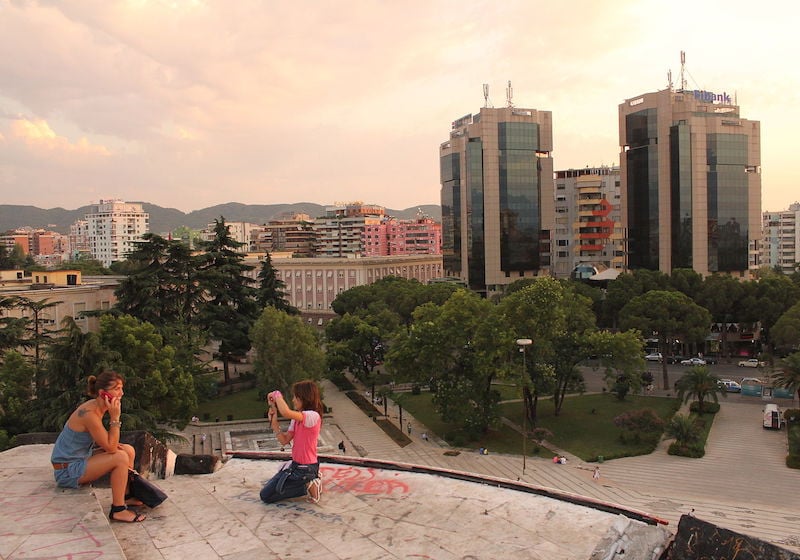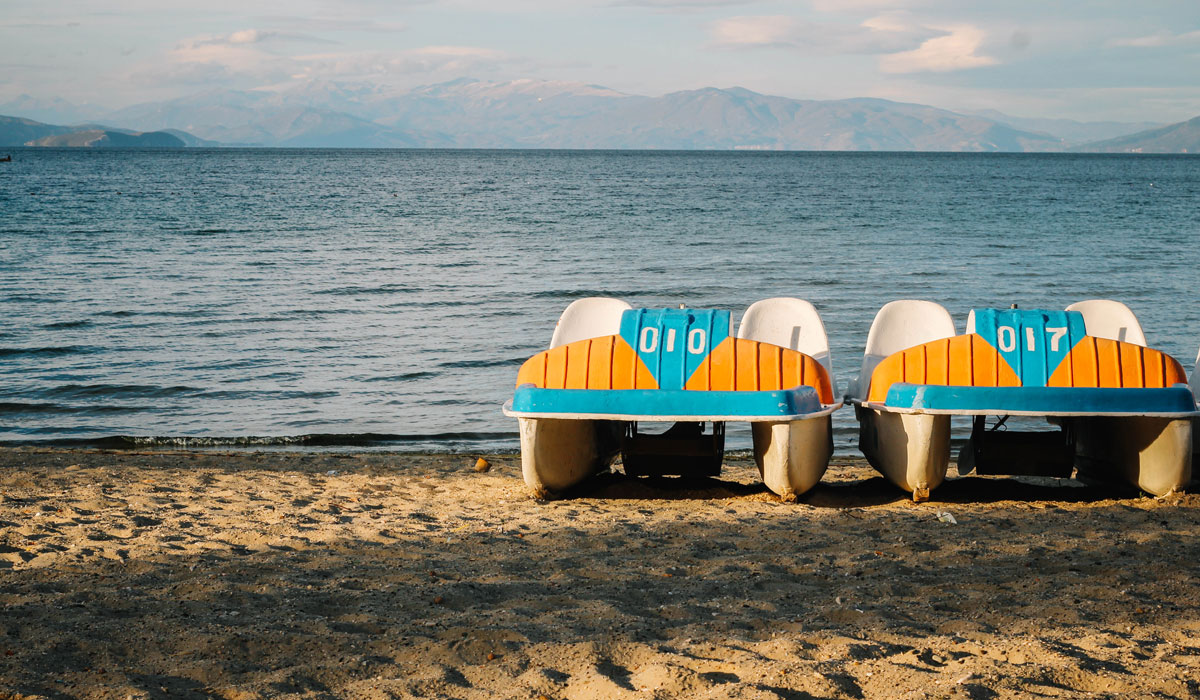5 destinations that prove Albania is perfect for your next climbing getaway
Mastered the ropes? Albania’s climbing routes are a wonderful introduction to the country’s spectacular natural scenery. Here are our top picks, scaled and tested.
Albania has long been one of Europe’s best-kept secrets, boasting ample natural beauty, stunning beaches, and crystal clear waters. The country has also has the makings of a world-class climbing destination, on par with the likes of Italy and Greece. It’s one of the rockiest countries in Europe, with mountainous terrain covering 70 per cent of the territory. Today, there are more than 80 established rock climbing routes across six sectors in Albania, with potential for thousands of additional lines, although establishing new routes has been somewhat limited.
“Tirana as a city is surrounded by beautiful mountains packed with perfect tufa limestone”
“Having a small community, [that is] not so experienced, as well as living in a country with a poor economy, means that it has always been a struggle to procure the budget for developing the climbing areas,” says Elion Çikopano, one of Albania’s main climbing route developers. To create new sport routes requires materials which include stainless steel bolts and anchors, along with high-powered drills and safety equipment. Çikopano estimates that new routes cost between €100-150 in equipment alone: no small sum in a country where the average monthly salary is €425.
“Unfortunately, national park agencies and municipalities still don’t have the vision to see the potential that they have and that climbing might bring [so we are doing much of this on our own],” notes Çikopano.
As a result, local climbers have looked to the international community to create awareness about the climbing in the country and to help support development efforts.
“Five years ago we decided to organise a yearly climbing festival,” says Çikopano, one of the co-organisers of the Albanian Climbing Festival, a yearly three-day event filled with climbing, slacklining, yoga sessions and stunning natural beauty. “The money that we pull from the tickets goes straight to the bolt fund, and [has allowed us to] start developing routes on our own.” They have added 50 new routes as a result of their five festivals so far.
Still, much of the bolting has been done by visiting climbers, many of whom learned about the country through the festival. The first event in 2015 attracted over 400 attendees and garnered international press that has led to growth in climbing-specific tourism ever since, including visits by some of the best in the world.
“Tirana as a city is surrounded by beautiful mountains packed with perfect tufa limestone,” shares Adam Ondra, considered to be the top climber today, in an instagram post from his climbing and bolting trip in 2018. “So far, only two areas of Brar and Bovilla have been bolted, counting around 20 routes each, but [with] potential of each area going into hundreds of routes,” he notes.
It is rare that so much untouched territory opens to outdoor sports, whether for climbing, hiking, mountain biking or otherwise, and assuring sustainable development is key for long-term viability.
Unfortunately, illegal hydropower dam projects threaten many of these same climbing areas by targeting the pristine rivers that run through them. The Vjosa and Valbona are considered some of the last wild rivers in Europe, and are home to about 70 endemic species of fish, along with critically-endangered species like the Balkan lynx.
To help combat improper exploitation, climbers are looking to use the sport as a way to sustainably cultivate tourism, provide jobs for locals, and protect the land for years to come.
“In Brar, a small family-run bar and restaurant in the village is getting twice the business since Adam Ondra published the crag in his account,” says Çikopano “In Bovilla, the number of restaurants has grown, and in Gjipe, the eco-camping site stays open all year long due to climbers visiting.”
The Albanian Riviera rivals the French and Italian in beauty, with the luxury of being much less toured
As climbing picks up, locals near the crags are seeing the importance of the rock around them. “For many villagers, tourism is becoming their main income,” notes Wolfgang Schüssler, a German climber active in developing Valbona in the north, and an anti-dam activist with TOKA. “Long-term, they are realizing that they have a big asset in natural resources, and they are seeing the importance of protecting it.”
For a sport that is reaching a fever pitch worldwide, Albanians are discovering the joys of ascent as well. Today, you can find over 60 school children scaling artificial walls at the country’s first rock climbing gym, Rock Tirana, which opened in 2012 and is now run by Çikopano, Enis Shehu, Irida Nallbani and Olbiano Xhaferaj.
“Seeing them grow, physically, mentally and in terms of climbing skills is one of our greatest achievements for the future of the climbing in Albania,” shares Çikopano. Thanks to a few impassioned climbers, Albanians are being introduced to rock climbing and the world is being reintroduced to the country.
Have we piqued your interest yet? Keep reading to find out where to go.
Bovilla
Lake-side climbing close to the capital
Climb above aquamarine waters with expansive views of rolling hills and serpentine mountain ranges at Bovilla (Bovillë). Located about an hour from Tirana the first sport climbing area in the country has an abundance of accessible routes in the range of 5b - 7c. Initial development began in 2010, and has been slowly built up from locals and foreigners ever since. Now, the limestone walls are a favorite for those looking to attempt their first top rope and lead climbs.
The style of climbing varies from steep overhanging at Tufa Palisades (on slithering yellow-tinted dihedrals) to slabby and less than vertical at the Lakeview crags, which as the name suggests, is accompanied by stunning overlooks of the man-made reservoir. The sectors sit on opposite sides of a ridge, which means you can climb in shade at the tufa sector in the morning, then move to the lake sector in the afternoon for a continued reprieve from the potent sun. In the summer, a small bar is open next to the river, where you can cool down by lounging in the waters with refreshments in hand.
Brar
First Ascent (FA) potential for the strong
There are no easy routes here. In fact, the canyon contains the hardest line in the Balkans, an Adam Ondra (considered by many to be the best climber in the world) bolted 9b, The Dream. The line was first sent (climbed in one go without falling) just before Christmas of 2019 by the French pro-climber, Seb Bouin. The route is representative of the terrain, comprised of uber steep and snaking tufas on yellow-orange-grey streaked limestone.
If you are among the strong, Tirana is well-positioned as a base for projecting since the crag is just a 20 minute drive from downtown. Once at the roiling and highly-featured walls, climbers will find warmpus that begin at 6c and many more routes above 7a. It is considered by locals as the best climbing in the country, which is evident by professionals from around the world taking up the challenge.
Gjipe
Idyllic setting along the Albanian Riviera
Residing at the mouth of Gjipe Canyon, the isolated beach is Albania’s most picturesque crag. The bolted lines emerge from the sun-bleached belay station like a fire-baked coral reef, while the waves gently purr like an air-percolator in a fish tank. Five meters of white sand separates you from the water’s edge, and come high tide, you are just this side of wet feet.
The Albanian Riviera rivals the French and Italian in beauty, with the luxury of being much less toured. To get there, drive four hours south from Tirana along the SH8 highway. The access road is located between the popular seaside towns of Dhërmi and Vuno. Note that there is no asphalt road, so either take four wheel drive, or enjoy a more leisurely pace by hiking in (about 30 minutes), or kayaking over from nearby Jale Beach. There are 30 to 40 bolted routes in the 5b – 8b range, with potential for much more.
Përmet
Climb up then heal up in thermal pools
Lengarica Canyon, close to Përmet, is better known for its numerous thermal pools, though its climbing potential should not be overlooked. The limestone chasm is situated within the Fir of Hotovë-Dangelli National Park, the largest of its kind in the country, and about a four hour drive southeast of Tirana. The canyon is roughly 4.5 km long with sheer wall heights of up to 150 metres. Featured climbing consists of overhanging lines, dramatic caves (known to contain human remains over 4,000 years old), bulbous tufas, and technical faces. Afterwards, relax in the restorative warm waters of the Lengarica River, which maintains a temperature of around 30 degrees Celsius all year-round.
Përmet, a former Ottoman village from the 15th century, features a prominent rock in the center of town filled with legend. The formation measures 42 meters high and has an archaeological site on top that may date back as far as the 4th century. The reverence for the stone stands as a symbolic testament to the proud lines to be found in Lengarica Canyon.
Theth
Big mountains and big lines up north
The “Chamonix” of Albania, Theth is a glaciated valley with perhaps the tallest rock face in the Balkan peninsula. Mt. Arapit, or the “Dark One,” is 2,217 metres high and features a south wall that rises an impressive 800 metres above the ground. In 2010, a German expedition completed the first free climb ascent of the face, which consisted of an 18-pitch, 7a route.
Theth is one half of the famous Valbona-Theth hike. The 17.5 kilometre trek takes about seven hours, and is actually faster to complete than a point-to-point drive (roughly 10 hours). Beginning your trip in Shkodër is the easiest way to get to Theth, though you can also reach the valley from Tirana in 4.5 hours by car. Note that you’ll need a four wheel drive to get to the base of the climbing routes.
Little has been developed here, though there is limitless potential. The immaculate alpine environment contains limestone massifs, the longest horizontal cave in the country, and fields of boulders. If you’re looking for a place to establish big wall climbs and shorter sport routes in an alpine arena, Theth should be your top destination.


